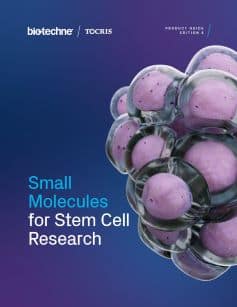FGFR
Fibroblast growth factors (FGFs) are mitogenic signaling molecules that have roles in angiogenesis, wound healing, cell migration, neural outgrowth and embryonic development. FGF receptors (FGFRs) are transmembrane catalytic receptors with intracellular tyrosine kinase activity.
FGFR Inhibitors |
|
|---|---|
| Cat. No. | 产品名称/活性 |
| 4274 | AP 24534 |
| Potent multi-kinase and pan-Bcr-Abl inhibitor | |
| 7823 | AZD 4547 |
| Potent and selective FGFR inhibitor | |
| 7454 | Cediranib |
| Potent inhibitor of VEGFR, PDGFR and FGFR | |
| 7049 | Nintedanib |
| Potent VEGFR, PDGFR and FGFR inhibitor | |
| 3724 | PD 161570 |
| Selective FGFR inhibitor | |
| 3785 | PD 166285 dihydrochloride |
| FGFR, PDGFRβ and Src inhibitor; also inhibits Wee1 | |
| 3044 | PD 173074 |
| FGFR1 and -3 inhibitor | |
| 3300 | SU 5402 |
| Potent FGFR and VEGFR inhibitor | |
Fibroblast growth factors (FGFs) (FGF1 - 10 and 16 - 23) are mitogenic signaling molecules that have roles in angiogenesis, wound healing, cell migration, neural outgrowth and embryonic development. FGFs bind heparan sulfate glycosaminoglycans (HSGAGs), which facilitates dimerization (activation) of FGF receptors (FGFRs).
FGFRs are transmembrane catalytic receptors that have intracellular tyrosine kinase activity. There are four human genes encoding FGFRs, which produce seven different receptors (FGFR1b, FGFR1c, FGFR2b, FGFR2c, FGFR3b, FGFR3c and FGFR4) due to alternative splicing events occurring both in the extracellular and intracellular regions. The alternative splice isoforms are generally tissue specific: the b isoform is expressed in epithelial tissue, whereas the c isoform is expressed in mesenchymal tissue. HSGAG-FGF-FGFR binding initiates FGFR dimerization, enabling the cytoplasmic kinase domains to transphosphorylate tyrosine residues and become activated. HSGAGs also function to stabilize FGF-FGFR binding and prevent FGF degradation.
FGFs were first isolated as growth factors for fibroblasts. Since the initial discovery of FGF1 and FGF2, a further 20 structurally related FGFs have been identified, all of which are differentially expressed in many tissues. Of these 22 growth factors, 18 are FGFR ligands. FGFRs couple to the PLCγ, MAPK and PI3-K/Akt intracellular signaling cascades and there is evidence of cross talk with the Notch signaling pathway. In addition, some activated FGF-FGFR complexes are endocytosed and function directly in the cytosol and/or nucleus of the cell.
Mutations in FGFR genes are the cause of several human developmental disorders characterized by skeletal abnormalities such as achondroplasia, and upregulation of FGFR expression may lead to cell transformation and cancer.
External sources of pharmacological information for FGFR :
Literature for FGFR
Tocris offers the following scientific literature for FGFR to showcase our products. We invite you to request* your copy today!
*Please note that Tocris will only send literature to established scientific business / institute addresses.
Stem Cells Scientific Review
Written by Kirsty E. Clarke, Victoria B. Christie, Andy Whiting and Stefan A. Przyborski, this review provides an overview of the use of small molecules in the control of stem cell growth and differentiation. Key signaling pathways are highlighted, and the regulation of ES cell self-renewal and somatic cell reprogramming is discussed. Compounds available from Tocris are listed.
Depression Poster
Major depressive disorder is characterized by depressed mood and a loss of interest and/or pleasure. Updated in 2015 this poster highlights presynaptic and postsynaptic targets for the potential treatment of major depressive disorder, as well as outlining the pharmacology of currently approved antidepressant drugs.
FGFR Gene Data
| Gene | Species | Gene Symbol | Gene Accession No. | Protein Accession No. |
|---|---|---|---|---|
| FGFR1 | Human | FGFR1 | NM_023110 | Q5BJG2 |
| Mouse | Fgfr1 | NM_010206 | P16092 | |
| Rat | Fgfr1 | NM_024146 | O35758 | |
| FGFR2 | Human | FGFR2 | NM_022976 | Q9UQH7 |
| Mouse | Fgfr2 | NM_010207 | P21803 | |
| Rat | Fgfr2 | NM_012712 | Q9R2A0 | |
| FGFR3 | Human | FGFR3 | NM_000142 | P22607 |
| Mouse | Fgfr3 | NM_008010 | Q61851 | |
| Rat | Fgfr3 | NM_053429 | Q9JHX9 | |
| FGFR4 | Human | FGFR4 | NM_022963 | P22455 |
| Mouse | Fgfr4 | NM_008011 | Q03142 | |
| Rat | Fgfr4 | NM_001109904 | Q498D6 |




